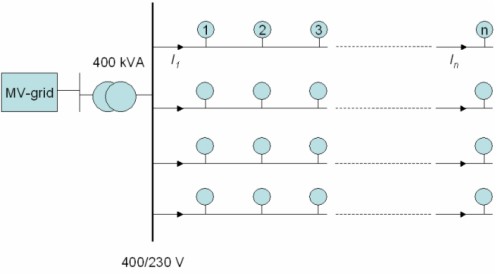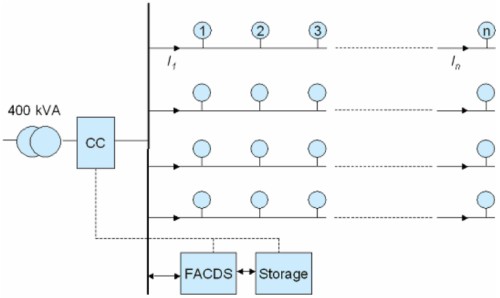Pilot Microgrids
F4. Continuon's MV/LV facility
Back
Continuon operates a holiday-parc with more then 200 cottages. A great number of these cottages are equipped with PV-generators, coupled to the grid by means of inverters. The total amount of installed PV-power is 315 kW. The cottages are connected to a MV/LV transformer using four LV-feeders as shown in figure 6.11. Each 3-phase feeder has a length of around 400 m.

Figure 6.11 - Electrical schema of the existing situation
The load of these cottages is during daytime low compared with the PV-power. So in daytime most of the PV-power is injected in the MV-grid. In the evening (and night) of course some support from the MV-grid is needed. During the several seasons the load and generation profiles will be different.
In the existing situation there are the following characteristics of the voltages.
- A high voltage at the cottages at the end of the feeder in the situation of maximum PV-power.
- A high level of voltage distortion during the periods of high PV-power.
Using FACDS (flexible AC Distribution systems, by means of power electronics) and a storage system as shown in figure 2 we want to establish:
- Islanded operation of the Microgrid (as long as possible)
- Improving the voltage level
- Improving the voltage shape (less harmonic distortion)

Figure 6.12 - Proposal to realise the stand-alone Microgrid
The MGCC (Microgrid Central Controller, CC in figure 6.12) is needed for synchronizing, load control and other safety and control actions.
In cooperation with Germanos and EMforce we want to realize a Microgrid based on the already installated PV-systems and a storage system.
For a successful implementation is needed:
- To analyse the technology and capacity of the storage system
- Testing the characteristics of the PV-systems, the storage system and their combination
- Study of controlling and regulating factors that would affect battery cycle life and discharge/recharge performance i.e. temperature, and depth, rate and number of discharge cycles, recharge methodology and self-discharge.
- Engineering the FACDS to solve the harmonic problem and to take care of the stability of the Microgrid in combination with the MGCC.
- Improve the power quality in general (sags)
- To study the protection problems (protection against electric shock, overcurrent, overvoltages) and if necessary implement a new protection philosophy.